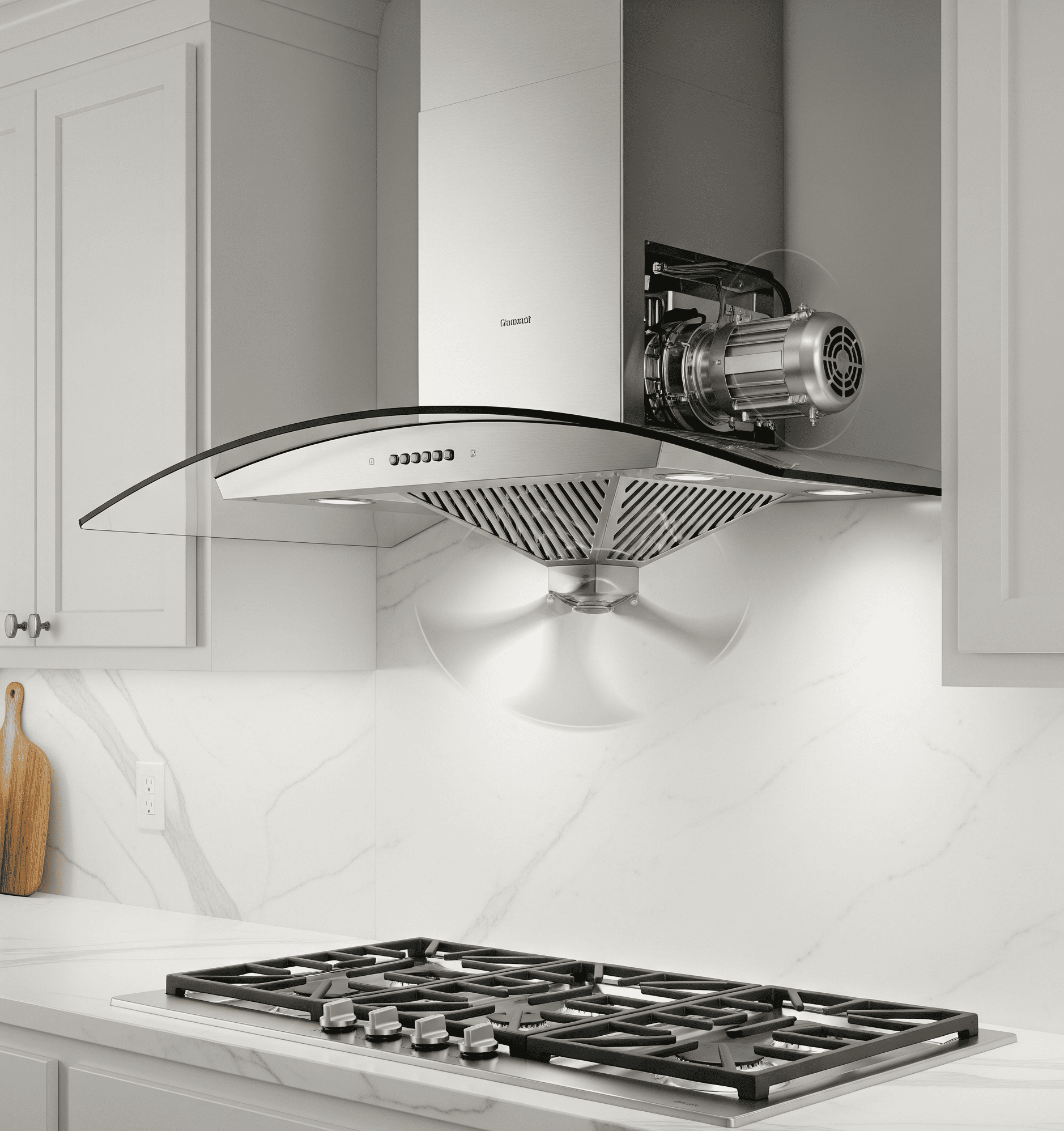Kingsgrove Branch:
How to Clean Kitchen Exhaust Fan

How to clean kitchen exhaust fan is a crucial task for maintaining a healthy and clean kitchen environment. A neglected exhaust fan can lead to a build-up of grease and odors, potentially affecting your home's air quality and even posing a fire risk. This comprehensive guide will walk you through the process, from preparing the fan for cleaning to reassembling it and maintaining its cleanliness for optimal performance
We'll cover various types of exhaust fan, providing tailored cleaning methods for each. This guide includes essential safety precautions and a step-by-step breakdown to ensure a safe and effective cleaning process. Plus, we'll offer some helpful tips to prevent future grease buildup and keep your kitchen exhaust fan humming for years to come
Keeping Your Kitchen Exhaust Fan Sparkling
A clean kitchen exhaust fan isn't just about aesthetics; it's about health and safety. Grease buildup can lead to fire hazards and unpleasant odors. This guide will walk you through the process of cleaning your kitchen exhaust fan, from initial prep to final reassembly
Introduction to Exhaust Fan Cleaning
Regularly cleaning your kitchen exhaust fan is crucial for maintaining a safe and healthy kitchen environment. Neglecting cleaning can lead to a buildup of grease, which can create a fire hazard and unpleasant odors. Different types of fans require different cleaning frequencies. Let's explore the different types and their recommended cleaning schedules
- Importance of Cleaning: Grease buildup significantly increases the risk of kitchen fires. It also makes your kitchen less pleasant to be in, due to the lingering smell and general uncleanliness
- Consequences of Neglect: Ignoring cleaning can lead to serious fire hazards, as grease can ignite easily. The lingering odors can make your kitchen uncomfortable and detract from the overall dining experience
- Cleaning Frequency: How often you clean your exhaust fan depends on the type of fan and how frequently you use your kitchen. A range hood used daily might need monthly cleaning, while a rarely used one could be cleaned every few months. Refer to the manufacturer's guidelines for specific recommendations
- Fan Types: Kitchen exhaust fans come in various forms, including range hoods (mounted above the stove), wall-mounted fans, and under-cabinet fans. Each type has its own unique design and cleaning requirements
| Fan Type | Cleaning Method | Tools Needed | Safety Precautions |
| Range Hood | Disassemble, clean components, reassemble | Gloves, cleaning solution, brushes, cleaning cloths | Disconnect power, wear eye protection |
| Wall-Mounted | Disassemble, clean components, reassemble | Gloves, cleaning solution, brushes, cleaning cloths | Disconnect power, wear eye protection |
Gathering Necessary Supplies
Before diving into the cleaning process, gather the necessary tools and materials. Safety first! Having the right supplies ensures a smooth and efficient cleaning job
- Tools: Gloves, cleaning cloths, brushes (stiff and soft), cleaning solution, possibly a degrease
- Safety Gear: Eye protection, rubber gloves are essential for protecting your skin and eyes from potential hazards
- Cleaning Solutions: Choose a cleaning solution suitable for your fan's materials. Mild dish soap or a dedicated degreaser are common options
- Checklist: A checklist will help you ensure you have everything you need
Preparing the Exhaust Fan for Cleaning
Safety is paramount. Properly disconnecting the exhaust fan from the power source and disassembling the components will make cleaning easier and safer
- Power Disconnection: Turn off the power switch to the exhaust fan at the circuit breaker. This is the most critical safety step
- Component Detachment: Detach filters, grills, and any removable components from the fan assembly
- Disassembly: Carefully follow the manufacturer's instructions to disassemble the fan. Refer to any diagrams or videos available for your specific fan model
Cleaning the Exhaust Fan Components, How to clean kitchen exhaust fan
Now, it's time to clean those components. Use appropriate cleaning methods and solutions for each part
- Cleaning Fan Blades and Motor: Use a soft brush to clean the fan blades and the motor, removing any accumulated grease or debris
- Cleaning the Exhaust Filter: Clean the filter thoroughly, often with soap and water, and rinse thoroughly. Replace the filter with a new one if it's severely damaged
- Cleaning Grease Traps: If your fan has grease traps or baffles, clean these thoroughly using a degreaser or a combination of hot water and dish soap
| Component | Cleaning Solution | Additional Notes |
| Blades | Mild dish soap and water, or a degreaser | Use a soft brush to avoid scratching |
| Filter | Hot water and dish soap | Replace if damaged beyond cleaning |
Reassembling the Exhaust Fan
Reassemble the fan in the reverse order of disassembly. This ensures all parts are correctly positioned
- Reverse Order: Follow the disassembly instructions in reverse order to ensure correct reassembly
- Visual Guide: If available, refer to diagrams or videos demonstrating the reassembly process
- Power Reconnection: Reconnect the exhaust fan to the power source after checking for proper assembly
- Safety Checks: Double-check all connections and components before turning the power back on. A thorough review is crucial for avoiding any issues
Maintaining the Cleanliness of the Exhaust Fan
Preventative maintenance is key to extending the life of your exhaust fan
- Preventative Maintenance: Regular cleaning and inspections can significantly increase the lifespan of your fan
- Cleaning Frequency: Regular cleaning will prevent grease buildup and keep your fan functioning optimally
- Grease Prevention: Using a grease filter or hood will help prevent grease from accumulating on the fan
- Inspection: Periodic inspections can help you catch any potential issues before they escalate
| Maintenance Task | Frequency | Description |
| Cleaning | Monthly (or as needed) | Thoroughly clean all components |
| Inspection | Quarterly | Check for any damage or wear and tear |
Final Wrap-Up
So, there you have it! A thorough guide to cleaning your kitchen exhaust fan, covering everything from initial prep to final reassembly. By following these steps, you can effectively clean your exhaust fan, maintaining its optimal performance, and creating a healthier and more pleasant kitchen environment. Remember to prioritize safety throughout the entire process. Proper cleaning and maintenance will help ensure your kitchen exhaust fan provides years of reliable service, see how to clean bathroom exhaust fan
Clarifying Questions: How To Clean Kitchen Exhaust Fan
How often should I clean my kitchen exhaust fan?
Ideally, clean your exhaust fan every 1-3 months, depending on the amount of cooking you do and the type of fan. More frequent cleaning is recommended if you cook frequently or have a high-volume range hood
What cleaning solutions can I use for different parts of the exhaust fan?
Mild dish soap and water is generally safe for most parts. For stubborn grease, a degreaser specifically designed for kitchen appliances is suitable. Avoid abrasive cleaners that could damage the fan components
What safety precautions should I take when cleaning the exhaust fan?
Always disconnect the exhaust fan from the power source before starting any cleaning process. Wear appropriate safety gear like gloves and eye protection to prevent injuries. Be cautious when handling wet or greasy parts
Recent posts

Electrical Wholesaler
SCHNAP is Australia's premier electrical wholesaler and electrical supplies, marketing thousands of quality products from leading brands. Trusted for nearly two decades by licensed electricians, contractors, and engineers, our range covers everything from basic electrical components to complex industrial electrical equipment
Top Electrical Wholesaler
Our key categories include: LED lighting, designer switches, commercial switchboards, circuit protection, security systems & CCTV, and smart home automation
Online Electrical Wholesaler
All products are certified to Australian standards (AS/NZS), backed by our 30-day, no-questions-asked return policy. Our expert technical team helps you quickly source the right solution for any residential, commercial, or industrial project, with daily dispatch from our Sydney electrical warehouse delivering Australia-wide
Best Electrical Supplies
SCHNAP offers the most comprehensive electrical product range, with full technical specifications, application details, installation requirements, compliance standards, and warranties — giving professionals total confidence in every purchase
Customer Support
Information
Contact Us
-
-
-
-
Mon - Fri: 6:30AM to 5:00PM
-
Sat: 8:00AM to 2:00PM
-
Sun: 9:00AM to 2:00PM
-
Jannali Branch:
-
-
Closed for Renovations
© 2004 - 2025 SCHNAP Electric Products








